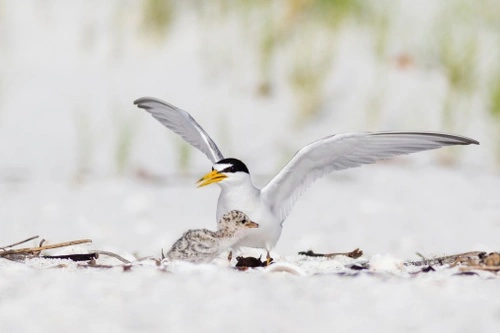
On October 24, 2019, the U.S. Fish and Wildlife Service (FWS) published a proposed rule in the Federal Register announcing the agency’s finding that the interior least tern (Sterna antillarum) is no longer warranted for listing as an endangered species under the Endangered Species Act (ESA).
The interior least tern, the smallest of the tern species in North America, was first observed in 1804 by explorers Meriwether Lewis and William Clark. The fish-mongering bird currently nests adjacent to major U.S. rivers within the Lower Mississippi Valley and the Great Plains region across 18 states.
Before it was listed as endangered under the ESA in 1985, the interior least tern experienced habitat loss and degradation from dam and reservoir construction, river and bank channelization, hydropower generation, and water diversion. Additionally, the introduction of invasive plants to the least tern’s sparsely-vegetated sandbar habitat contributed to its decline. But as the FWS noted in its news release announcing the delisting proposal, it was the abundant harvesting of the least tern’s feathers for hat-making in the 19th and 20th centuries that decimated the population to near extinction. The Federal Register notice for the proposed rule states that at the time of listing, fewer than 2,000 least terns remained.
In its Federal Register notice for the proposed rule, the FWS states that over the last 34 years, collaboration among dozens of government agencies, landowners, industrial partners, and environmental organizations across several states helped the interior least tern’s population increase considerably. The notice further provides that restoration plans such as the Platte River Recovery Implementation Program collectively led to a reduction, or even complete elimination, of the threats identified for the species at the time of listing.
In particular, the FWS credits the tern’s recovery to the decades-long partnership between the FWS and the U.S. Army Corps of Engineers (Corps) in implementing conservation measures that improved the bird’s critical habitat. Through its 2005 rangewide monitoring program, the Corps confirmed that the tern’s population had been increasing in the decades since conservation efforts began.
The FWS initially proposed removing the interior least tern from ESA listing in 2013 after concluding in a status review that the species’ population had recovered. Since then, the Corps has developed new monitoring and conservation plans to maintain the population improvements post-delisting.
The proposed rule states that FWS based its decision to delist the species on the best available scientific and commercial data, which indicates that the least tern no longer fits the definition of endangered under the ESA. The interior least tern’s current estimated population, at over 18,000, is more than ten times what it was at the time of its listing in 1985. Additionally, the review by FWS shows that previous threats to the tern’s population, including habitat loss, curtailment of range, predation, and inadequacy of regulatory mechanisms no longer exist or have been adequately reduced.
The agency’s proposed rule and supporting documents, including a draft post-delisting monitoring plan, are available at regulations.gov, Docket Number FWS–R4–ES–2018-0082. The 60-day period for public comment on the proposed rule and draft monitoring plan is currently set to end on December 23, 2019.
Nossaman’s Endangered Species Law & Policy blog focuses on news, events, and policies affecting endangered species issues in California and throughout the United States. Topics include listing and critical habitat decisions, conservation and recovery planning, inter-agency consultation, and related developments in law, policy, and science. We also inform readers about regulatory and legislative developments, as well as key court decisions.
Stay Connected
 RSS Feed
RSS Feed
Categories
- Alternative Energy
- Bald and Golden Eagle Protection Act
- Budget
- CEQA
- CESA
- Climate Change
- Congress
- Conservation
- Construction Projects
- Consultation
- Continuing Education
- Court Decisions
- Critical Habitat
- Delisting
- Endangered Species Act
- Event
- Fish & Wildlife Service
- Freedom of Information Act
- Government Administration
- Legal
- Legislation
- Listing
- Litigation
- Migratory Bird
- National Marine Fisheries Service
- NEPA
- Off Shore Wind
- Pacific Northwest
- project
- Publications
- Regulatory Reform
- Sacramento-San Joaquin Delta
- SEPA
- Speaking Engagements
- Supreme Court
- Texas
- Timberland
- Water Issues
